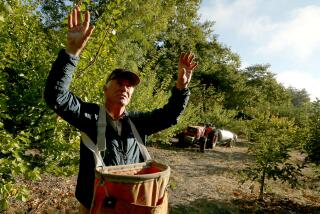Apple-Picking Time Across the U.S. : Near-Capacity Yield Is Projected for the 1987 Harvest
- Share via
NEW YORK — It’s apple-picking season in many parts of the United States. Orchards across the country are open to those who want to pick their own fruit.
Apple harvesting begins in some parts of the United States in late August, so some apple varieties have matured. Others will be ready for picking in the weeks ahead. The apple harvest usually comes to an end in early November.
The International Apple Institute in McLean, Va., says apples are grown in every continental U.S. state, but primarily in 18 states: Washington, New York, Michigan, Pennsylvania, California, Virginia, North Carolina, West Virginia, Oregon, Ohio, Idaho, New Jersey, Massachusetts, Illinois, Maine, Maryland, Colorado and Indiana.
The Apple Institute says the 1987 apple harvest is projected to total 230.7 million bushels--near full-capacity--and a 23% increase over the 1986 crop.
The institute says the average U.S. consumer eats about 50 apples a year; that’s about 18 pounds per person.
Many consumers keep apples at room temperature. But the institute says apples stay fresh up to 10 times longer in the refrigerator. So store apples in the vegetable crisper or in a plastic bag in the coldest part of the refrigerator.
If there’s not enough room in the refrigerator, wrap each unblemished fruit in paper and store in slotted boxes in a cool, dark, well-ventilated place.
Another good way to preserve an orchard’s worth of apples is to core, peel and slice the apples, dunk the slices in lemon juice, pack closely in a container and freeze.
Or, make a huge batch of applesauce and freeze it in small containers.
If there’s no room in the freezer, peel, core and slice the apples and soak them in lemon juice to keep them from browning. Place slices on screen racks, slotted pans or cloth-lined trays and dry them in the hot sun.
Apples also can be dried in an oven. However, the drying process varies, depending on oven or room temperature. Set the oven temperature between 105 and 150 degrees maximum--until a slice cut in half renders no moisture when squeezed.
Dried apples can be stored in air-tight containers in a cool, dark place for months. They can be reconstituted by soaking them for several hours in warm water and lemon juice.
Plenty to Choose From
There are more than 300 varieties of apples harvested during the apple season, but 12 varieties are most generally available on the market throughout the year. These varieties are:
--Red Delicious, sweet, tender and juicy. It’s best used for crunching out of hand and in fruit cups and salads.
--Golden Delicious, a sweet, firm, low-acid apple with golden skin and flesh that remains white longer. Golden Delicious is excellent for all uses, including snacking.
--McIntosh, two-toned, with red and green skin. The McIntosh apple is especially juicy, with a slightly tart taste. It is considered the most aromatic of all apples. The McIntosh is good for snacking and for salads.
--Rome Beauty, firm and slightly tart, with red and red-striped skin. Rome Beauty is harvested late in the season. It is excellent for baked apples.
--York, firm and crisp with a slightly tart flavor. The York, with its lopsided shape and red and green skin, is great for cooking or eating.
--Jonathan, beautiful, brilliant red in color. Jonathan is tart, firm and juicy with excellent fragrance and flavor. It’s great for fresh eating and is also good for cooking.
--Granny Smith, moderately tart, very firm flesh, sprightly flavored. This green-skinned apple is popular for snacks, salads and all culinary uses.
--Stayman, mildly tart, deep red, rich flavor. The Stayman apple is a good, all-purpose apple that is popular for snacks and is good for all culinary uses.
--Winesap, one of the oldest known varieties in America. This apple has a deep red color. It is moderately tart and has firm flesh. The Winesap is excellent for fresh eating and for all baking needs.
--Cortland, deep, purple-red color. The Cortland resists bruising. It’s snow-white flesh, which stays white longer when cut, makes it great for salads and fruit cups. It’s also good for cooking.
--Northern Spy, large red and green-skinned. The Northern Spy is rich, spicy and has a moderately tart flavor. It is a favorite for apple pies and is great for snacks and salads.
--Gravenstein, red-striped, moderately tart in flavor. The Gravenstein, which is harvested in the early fall, is excellent for cooking. It is widely used in applesauce. And it is a good munching apple.
More to Read
Eat your way across L.A.
Get our weekly Tasting Notes newsletter for reviews, news and more.
You may occasionally receive promotional content from the Los Angeles Times.










